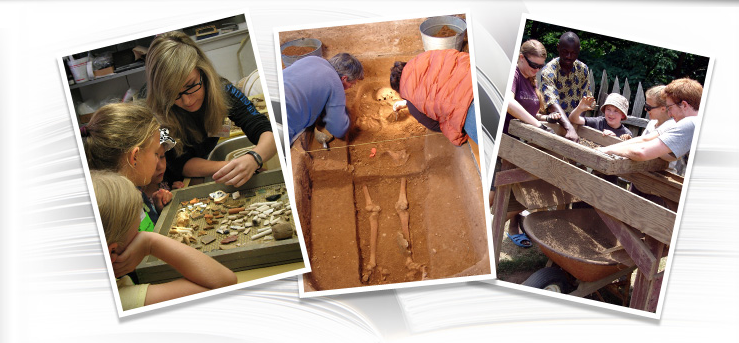2013 Week 5
Field school has now completed the fifth week of the project, which is our halfway point. By now, the students are familiar with the record-keeping system, how to recognize soil changes, and are working on their skills at making flat floors and straight walls. Things are moving more quickly as their knowledge increases. As I look at the research design and the time left, I wonder if we will be able to get everything done in the next five weeks?
Last summer, near the west end of the house foundation, we discovered a fenceline running southeast. This was the first fence known to be associated with the south side of the building. As the main entrance to the structure was on this side, this fence is important to understanding of how the front yard was being used. Because the builders’ trench for the brick cellar cuts through this fence, we know it was created before ca. 1678. Following this fence, knowing where it runs and what it relates to, will help us understand this part of the building.
To investigate this question, we excavated a unit 10 feet away from where the fence had previously been found.
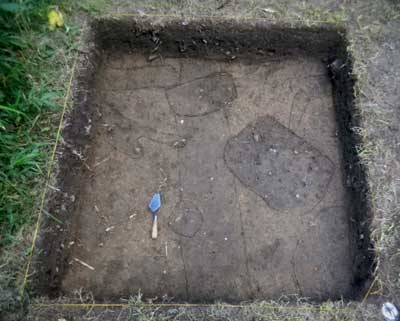
Early fence coming from the front of the house.
This was a very busy square with many features. Several of the features, which have large amounts of coal in them, are probably planting holes associated with the Brome family in the 19th century. The most important feature, for our purposes, runs directly through the center of the unit from top to bottom. This is the fence which we sought. Based on previous excavations, the unit directly south of this should contain several late period fences running east – west, parallel to the foundation. We will excavate that square to assess the relationship between these fences and the one that goes south from the foundation.
The presence of the fence coming off the foundation on this side has a significance beyond its simple function. Fences divide space, inside – outside, public – private, etc. This fence adds to our understanding of where the main door of the building might have been. The kitchen was located on the west side of the building and the yard outside the kitchen was the location of a large deposition of trash. The fence divides that private space from the very public entrance to the building and indicates that the main entrance must be to the east of it.
One of the more interesting artifacts found this week was a beautiful, oval bead with dark and light blue stripes.
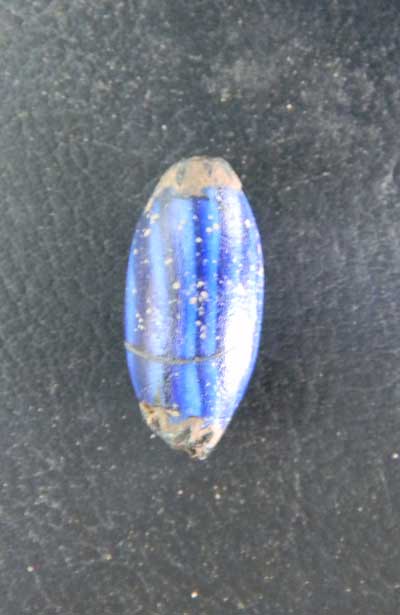
Glass trade bead.
Finding a bead is always an important event as they are both rare and they take a good eye to find amidst the gravel and soils. This one is unusual and further research will probably tell us more about it. However, what makes this bead special is that it was found by one of our volunteers. He has worked with us for six summers and had never found a bead. We were all very happy for him.
One of our main efforts over the next five weeks will be focused on the covered cellar and the fence that cuts across the top of it.
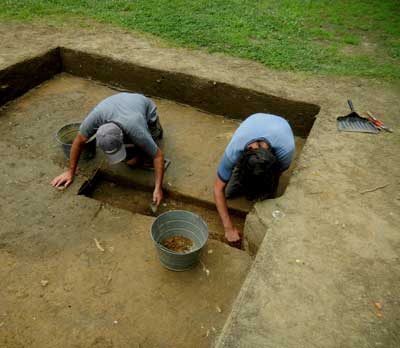
Excavation of the fence on top of the covered cellar.
This week, we began excavating a portion of the fence. When excavating a fence like this, our goal is to try to define what was the shape of the palings used to make the fence. Were they split logs, or saplings or planks? These paling molds are seldom visible at the surface but become clearer as we excavate. Before we begin, we use a coring tool to find out how deep the feature is and then excavate to a halfway mark, looking for the molds. Sometimes, like this fence, the molds are ambiguous.
As expected, the excavation of the fence has provided information on the cellar it cuts through.
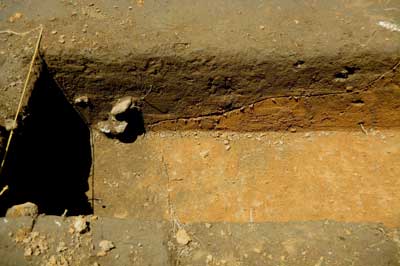
Profile of the eroded wall of the covered cellar, as seen in the wall of the fence trench.
We expect that the cellar hole was originally dug as a square hole but currently it looks circular. The profile shows that the upper portion of the walls of the cellar have eroded and that its surface shape does not reflect its original shape. The line at the bottom of the fence trench might be the actual wall of the cellar.
The fence trench had very few artifacts in it and most of those were of prehistoric origin. The only significant item was a glass bottle neck, one of three found on the site this week.
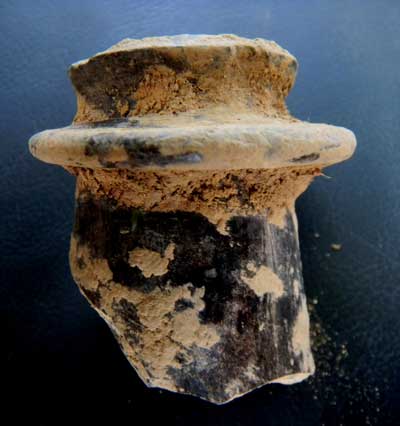
Bottleneck found in the fill of the fence trench.
The lack of artifacts in the fence is an indication of an early date. It was dug and filled in during a time when there were not may artifacts strewn across the site. Later fences, particularly this close to the house, generally have a significant quantity of artifacts included. This is another indication that the covered cellar is also an early feature. Next week, we will remove that other half of the fence line and perhaps, begin to investigate the cellar itself.


